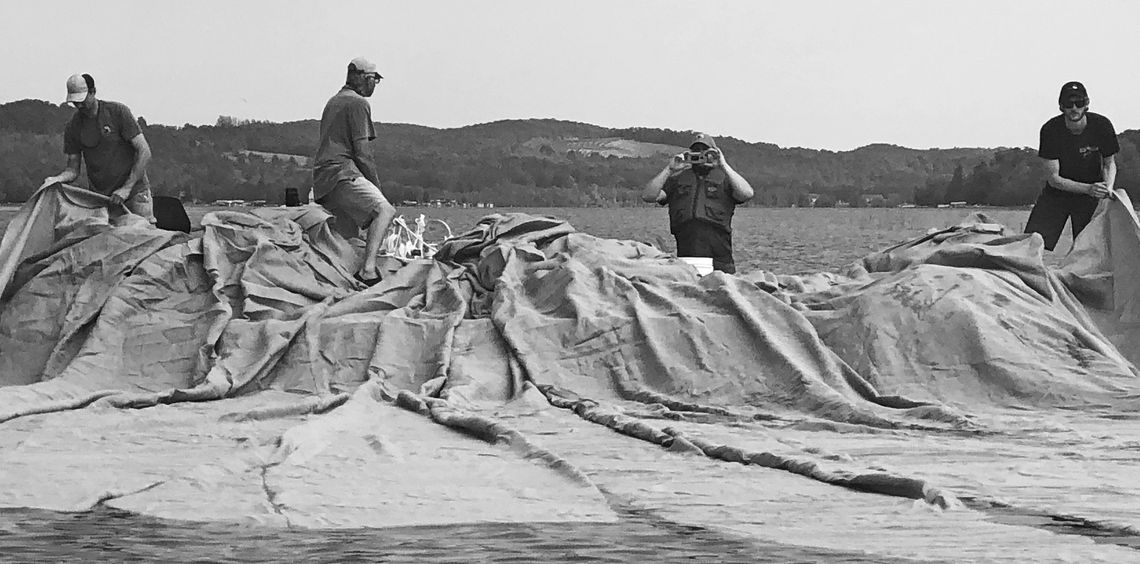With the 2024 field season now wrapped up as of August, the Lake Leelanau Lake Association (LLLA) reports that not only was it very successful in the fight against invasive Eurasian watermilfoil (EWM), but they have also taken away a lot of useful non-chemical methods to continue protecting the area in the future.
LLLA Director of Administration and Programs and Dive Team Leader, Annalise Povolo, said the project, which partners with the Grand Traverse Band of Ottawa and Chippewa Indians (GTB) to fight EWM, has seen much progress over the last five years since it started. EWM is described as “one of the most invasive and noxious aquatic invasive species in North America due to its ability to grow up to the surface of the lake in thick, dense mats which inhibit recreational and ecosystem functions on the lake.” After years of testing different control methods, both LLLA and GTB now rely on “benthic barriers” to kill EMW. According to LLLA, the barriers are made of biodegradable burlap blankets which are laid on top of the plant to prevent its ability to grow.
“It (the burlap) prevents it (EWM) from getting sunlight, and then it can’t photosynthesize and it dies…” Povolo explained. “We have been putting it in the lake every year because we’re covering different infestations. It’s biodegradable, so it’s okay to keep it in the lake.”
Povolo said another important fact they’ve learned over the years is that if every single strand of EWM is not covered, then people may need to come back and cover up some areas again. The invasive species can reproduce from fragmentation, so if a little piece falls off, Povolo said the plant fragments can settle on some of the burlap placed and put roots down through it from above. Since 2023, LLLA has adopted the “no strand left behind” method, in which “the crew will not leave an infestation until they are at least 95% sure that all of the visible infestation has been covered with burlap.” When the EWM is controlled, it becomes a maintenance site, lessening the number of fragments in the lake that could latch on and grow elsewhere. A site is considered “eradicated” if there is no EMW detected for at least three consecutive years.
“Our work is really dependent not just on the temperature, but the wind and the waves, so we wrap up by the end of August also because of our contract workers… but it really involves getting everything that we had to cover this year and making sure that every known infestation was covered,” she said. “So we do a lot of surveying throughout the year, but then we also do a big final survey of the lake in September to make sure that we know what might be left and be able to prepare for what we’ll have to do the following year.”
In an August update, the LLLA said there are now 14 areas in South Lake Leelanau that moved into the “maintenance site phase and are clean of EMW,” with ongoing checks of these sites in the years ahead ensuring it stays controlled.
While most of the areas in the lake were covered and maintained this year, Povolo said next year’s situation could look completely different.
“The prolonged warm season we’re having right now, who knows what effect that will have,” she said. “We didn’t have ice on the lake last year or very little the previous year, so that changes things, so you just don’t really know exactly what will come.”
EWM isn’t the only invasive species that the LLLA is monitoring the water. She said there are other invasives that are constantly a threat and present in the lake, such as the curly-leaf pondweed identified in recent years. Although there are four boat cleaning stations off Lake Leelanau, there are over 10 public boat launches, making way for many avenues for invasive species to come in through.
“So as much as we do our best to educate people on how to prevent invasive species by washing their boat, there’s still a lot of work to do on that front and a lot of risks that other invasive species could still come in. We just have to try to be as prepared as we can to tackle that,” she said.
For more information on what LLLA is working on, go online to https://lakeleelanau.org.








